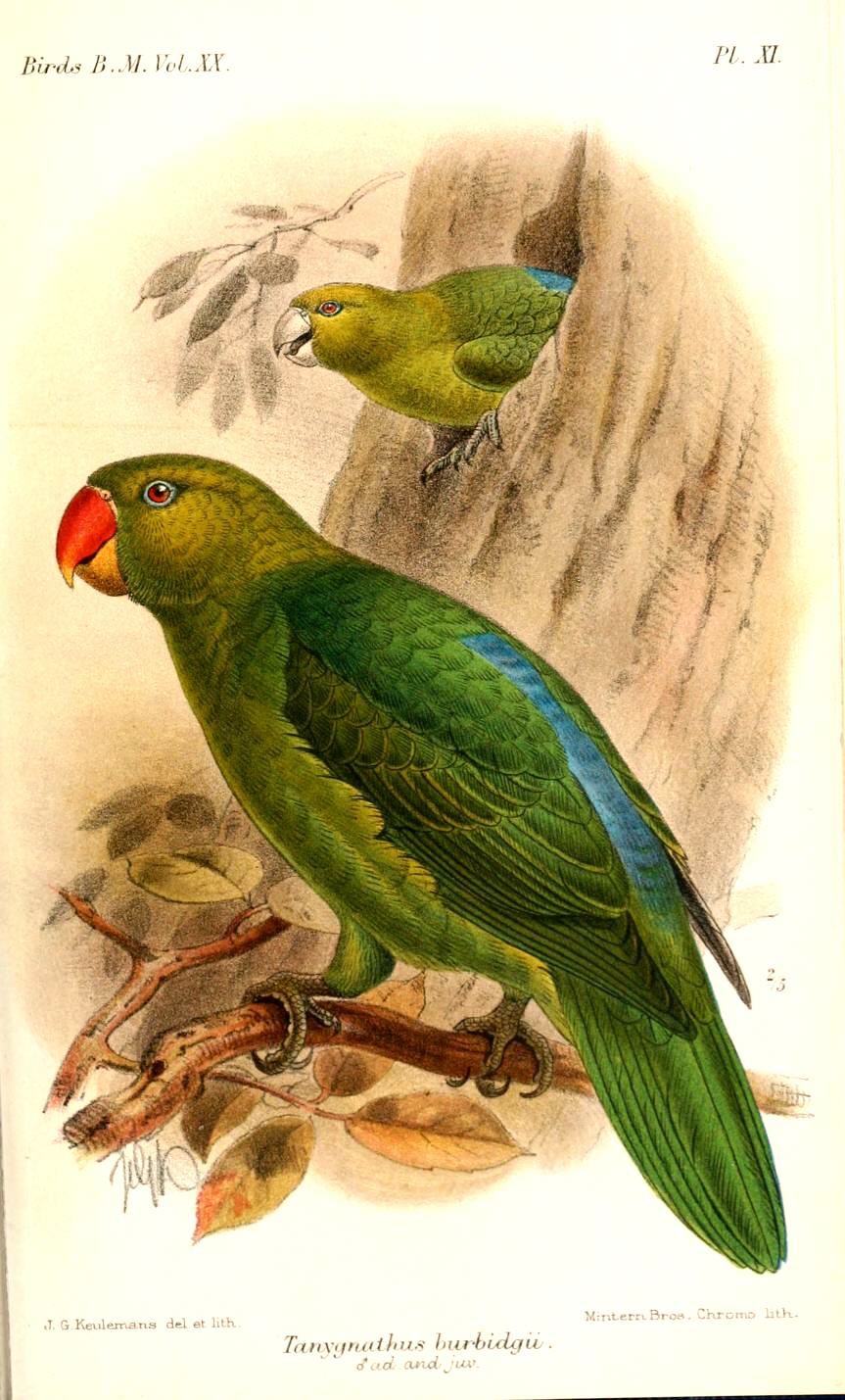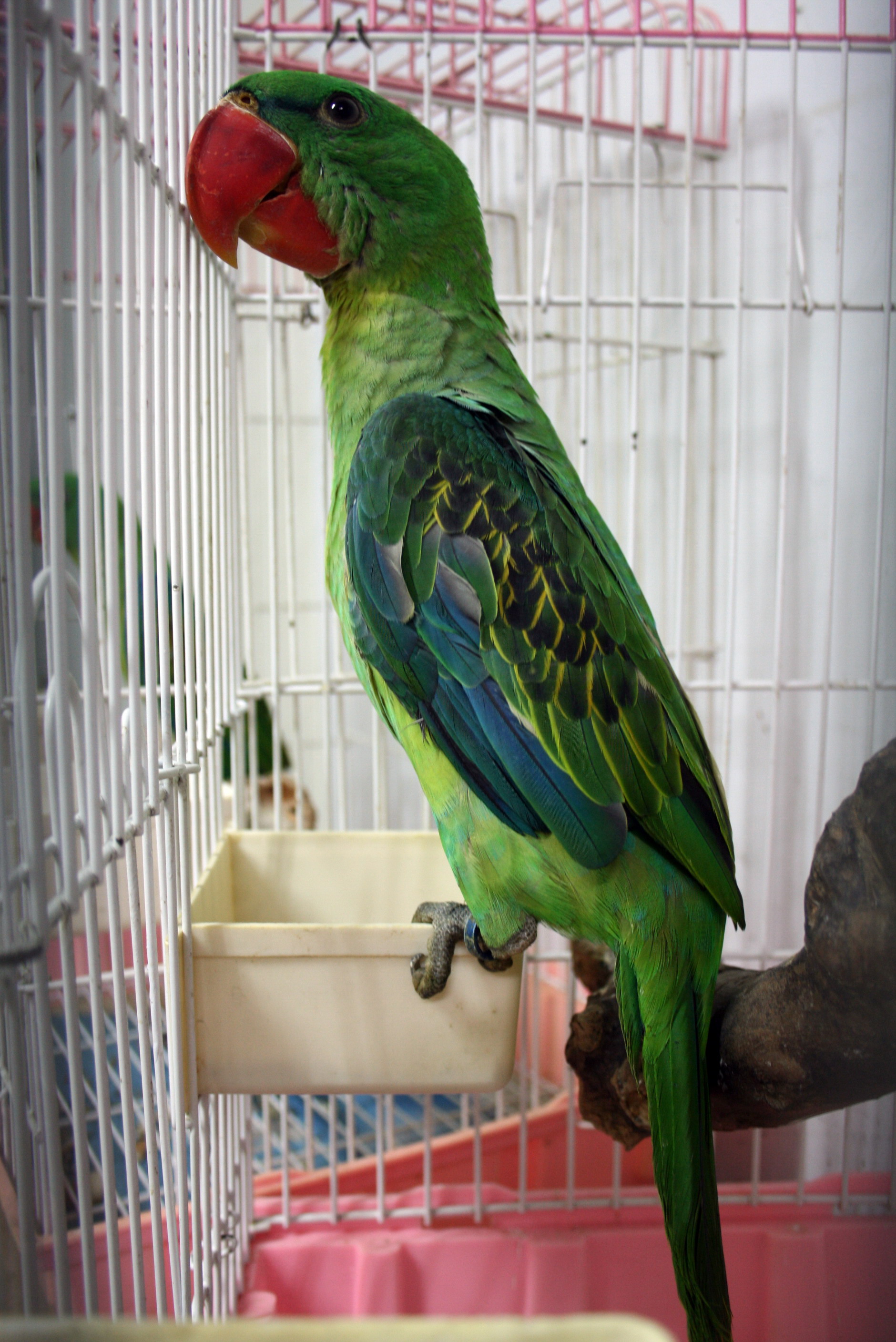|
Blue-backed Parrot
The blue-backed parrot (''Tanygnathus everetti''), also known as Müller's (or Mueller's) parrot and Burbridge's parrot (for the Sulu subspecies) is a large, Endangered species, endangered species of parrot Endemism, endemic to the Philippines. It is found in tropical moist lowland forest but is now feared locally extinct in a large part of its range including Negros, Panay, Leyte, Luzon and Polillo Islands, Polilio. The only recent records are in Samar, Mindanao and Tawi-Tawi, Tawi-tawi with the population being estimated below 250 individuals. Flocks are small and often active at night. Its main threats are Habitat destruction, habitat loss and Wildlife trade, trapping for the pet trade. It is illegal to hunt, capture or possess blue-backed parrots under Philippine Law RA 9147. Description It is of medium size (32 cm), primarily green with yellowish edging to the wings, a blue rump, and blue wing bends. The head, mantle, wings and tail are darker green, the belly and collar ... [...More Info...] [...Related Items...] OR: [Wikipedia] [Google] [Baidu] |
Arthur Hay, 9th Marquess Of Tweeddale
Colonel Arthur Hay, 9th Marquess of Tweeddale, (9 November 1824 – 29 December 1878), known before 1862 as Lord Arthur Hay and between 1862 and 1876 as Viscount Walden, was a Scottish soldier and ornithologist. Life Lord Arthur Hay was born at Yester House near Gifford, East Lothian, the son of General Sir George Hay, 8th Marquess of Tweeddale and his wife, Lady Susan Montague. He was sent to university in both Leipzig and Geneva. Training in the military he received a commission in the British Army in 1841. He rose to be a Colonel in the Grenadier Guards. He served as a soldier in India and the Crimea. He succeeded his father in the Marquessate in 1876. Hay purchased a lieutenancy in the Grenadier Guards in 1841. He purchased a captaincy in 1846 and was promoted lieutenant-colonel without purchase in 1854 and Colonel in 1860. In 1866 he transferred to the 17th Lancers. He was president of the Zoological Society of London from 16 January 1868. He had a private colle ... [...More Info...] [...Related Items...] OR: [Wikipedia] [Google] [Baidu] |
Azure-rumped Parrot
The azure-rumped parrot (''Tanygnathus sumatranus'') is a large bird endemic to Indonesia. It is found in Sulawesi and the Sangir Islands. It was previously conspecific with the blue-backed parrot, which is differentiated with its red iris and blue back versus the azure-rumped parrot's yellow iris and plain back. It is found in forests. Flocks are small and often active at night. Its main threats are habitat loss and trapping for the pet trade. Taxonomy There are two subspecies: * ''Tanygnathus sumatranus sumatranus'' ( Raffles, 1822): Sulawesi. Sulawesi and nearby islands. Yellow iris. * ''Tanygnathus sumatranus sangirensis'' Meyer, AB & Wiglesworth, 1894: Sangir Islands and Karakelong. More blue on wing bends and wing coverts, head darker green. Yellow iris Previously, only ''sumatranus'' was recognized, but ''sangirensis'' was also recognized by the International Ornithological Congress in 2022 based on phylogenetic evidence. Description It is of medium size (32&n ... [...More Info...] [...Related Items...] OR: [Wikipedia] [Google] [Baidu] |
Tanygnathus Sumatranus 1984 Stamp Of The Philippines
''Tanygnathus'' is a genus of parrots in the Psittaculini tribe, of the superfamily of Psittacoidea (true parrots). Its species are native to Southeast Asia and Melanesia. Taxonomy The genus ''Tanygnathus'' was introduced by the German naturalist Johann Wagler in 1832. The type species was subsequently designated as the great-billed parrot (''Tanygnathus megalorynchos'') by the English zoologist George Robert Gray in 1840. The name ''Tanygnathus'' combines the Ancient Greek words ''tanuō'' "to stretch out" and ''gnathos'' "jaw". The genus contains five species: Genetic analysis has supported reclassifying all 4 species under ''Psittacula ''Psittacula'', also known as Afro-Asian ring-necked parrots, is a genus of parrots from Africa and Southeast Asia. It is a widespread group with a clear concentration of species in south Asia, but also with representatives in Africa and the isla ...'', making ''Tanygnathus'' a synonym of the former genus. References Psittacul ... [...More Info...] [...Related Items...] OR: [Wikipedia] [Google] [Baidu] |
Oriental Bird Club Checklist
''An Annotated Checklist of the Birds of the Oriental Region'' is a 1996 softback book published by the Oriental Bird Club, and authored by Tim Inskipp, Nigel Lindsey and Will Duckworth. It contains a list of all 2,586 species recorded in the Oriental Bird Club's areas of operation up to the date of publication. This area approximates to that covered by the Oriental zoogeographical region, with the exception that for countries such as China and Pakistan which straddle the Oriental / Palaearctic boundary, the whole country is included; those species which do not occur within the Oriental region, are however indicated, so the book also serves as a list for the zoogeographical region. Prior to the publication of this work, no such publication existed. For its higher-level taxonomy, the book uses the Sibley–Ahlquist classification, but for species-level taxonomic decisions, the authors reviewed individual cases themselves, explaining the reasons for their decisions in annotations a ... [...More Info...] [...Related Items...] OR: [Wikipedia] [Google] [Baidu] |
Sulu Islands
The Sulu Archipelago ( Tausug: Kapū'-pūan sin Sūg Sulat Sūg: , ) is a chain of islands in the Pacific Ocean, in the southwestern Philippines. The archipelago forms the northern limit of the Celebes Sea and southern limit of the Sulu Sea. The Sulu Archipelago islands are within the Mindanao island group, consisting of the Philippines provinces of Basilan, Sulu, and Tawi-Tawi; hence the archipelago is sometimes referred to as Basulta, derived from the first syllables of the three provinces. The archipelago is not, as is often supposed, the remains of a land bridge between Borneo and the Philippines. Rather, it is the exposed edge of small submarine ridges produced by tectonic tilting of the sea bottom. Basilan, Jolo, Tawi-Tawi and other islands in the group are extinct volcanic cones rising from the southernmost ridge. Tawi-Tawi, the southernmost island of the group, has a serpentine basement-complex core with a limestone covering. This island chain is an important migr ... [...More Info...] [...Related Items...] OR: [Wikipedia] [Google] [Baidu] |
Samar (island)
Samar ( ) is the third-largest and seventh-most populous island in the Philippines, with a total population of 1,909,537 as of the 2020 census. It is located in the eastern Visayas, which are in the central Philippines. The island is divided into three provinces: Samar (formerly Western Samar), Northern Samar, and Eastern Samar. These three provinces, along with the provinces on the nearby islands of Leyte and Biliran, are part of the Eastern Visayas region. About a third of the island of Samar is protected as a natural park, known as the Samar Island Natural Park. Many names, such as ''Samal'', ''Ibabao'', and ''Tandaya'', were given to the island prior to the arrival of the Spaniards in 1596. During the early days of Spanish occupation, Samar was under the jurisdiction of Cebu. It later became part of Leyte in 1735 until its separation to become a distinct province named Samar in 1768. On June 19, 1965, through Republic Act No. 4221, Samar was divided into three province ... [...More Info...] [...Related Items...] OR: [Wikipedia] [Google] [Baidu] |
Leyte (island)
Leyte ( ) is an island in the Visayas group of islands in the Philippines. It is eighth-largest and sixth-most populous island in the Philippines, with a total population of 2,626,970 as of 2020 census. Since the accessibility of land has been depleted, Leyte has provided countless number of migrants to Mindanao. Most inhabitants are farmers. Fishing is a supplementary activity. Rice and corn (maize) are the main food crops; cash crops include coconuts, abaca, tobacco, bananas, and sugarcane. There are some manganese deposits, and sandstone and limestone are quarried in the northwest. Politically, the island is divided into two provinces: (Northern) Leyte and Southern Leyte. Territorially, Southern Leyte includes the island of Panaon to its south. To the north of Leyte is the island province of Biliran, a former sub-province of Leyte. The major cities of Leyte are Tacloban, on the eastern shore at the northwest corner of Leyte Gulf, and Ormoc, on the west coast. Leyte tod ... [...More Info...] [...Related Items...] OR: [Wikipedia] [Google] [Baidu] |
Negros Island
Negros (, , ) is the fourth largest and third most populous island in the Philippines, with a total land area of . The coastal zone of the southern part of Negros is identified as a site of highest marine biodiversity importance in the Coral Triangle. Negros is one of the many islands of the Visayas, in the central part of the country. The predominant inhabitants of the island region are mainly called Negrenses (locally ''Negrosanons''). As of 2020 census, the total population of Negros is 4,656,893 people. From 2015 to 2017, the whole island was governed as an administrative region officially named the Negros Island Region, which comprised the highly urbanized city of Bacolod and the provinces of Negros Occidental and Negros Oriental, along with its corresponding outlying islands and islets within a total regional area of . It was created on May 29, 2015, by virtue of Executive Order No. 183 issued by President Benigno Aquino III. On August 9, 2017, the region was dis ... [...More Info...] [...Related Items...] OR: [Wikipedia] [Google] [Baidu] |
Subspecies
In Taxonomy (biology), biological classification, subspecies (: subspecies) is a rank below species, used for populations that live in different areas and vary in size, shape, or other physical characteristics (Morphology (biology), morphology), but that can successfully interbreed. Not all species have subspecies, but for those that do there must be at least two. Subspecies is abbreviated as subsp. or ssp. and the singular and plural forms are the same ("the subspecies is" or "the subspecies are"). In zoology, under the International Code of Zoological Nomenclature, the subspecies is the only taxonomic rank below that of species that can receive a name. In botany and mycology, under the International Code of Nomenclature for algae, fungi, and plants, other infraspecific name, infraspecific ranks, such as variety (botany), variety, may be named. In bacteriology and virology, under standard International Code of Nomenclature of Prokaryotes, bacterial nomenclature and virus clas ... [...More Info...] [...Related Items...] OR: [Wikipedia] [Google] [Baidu] |






